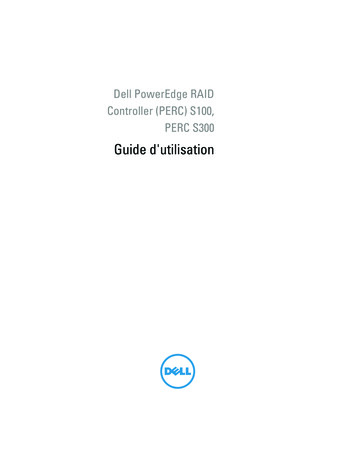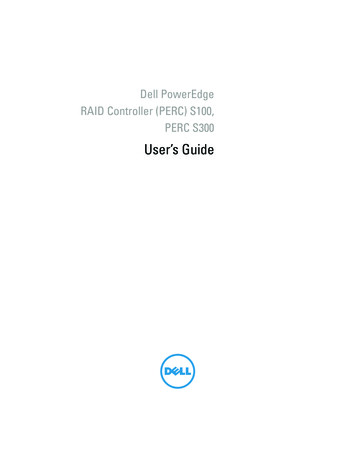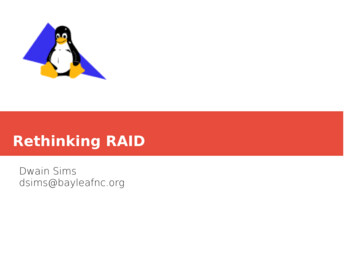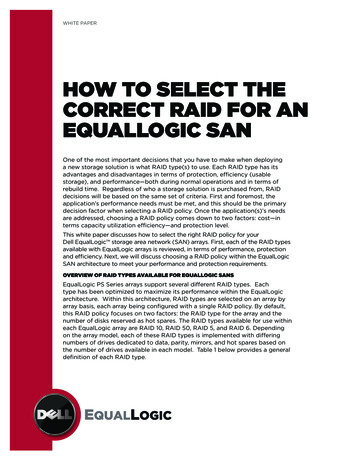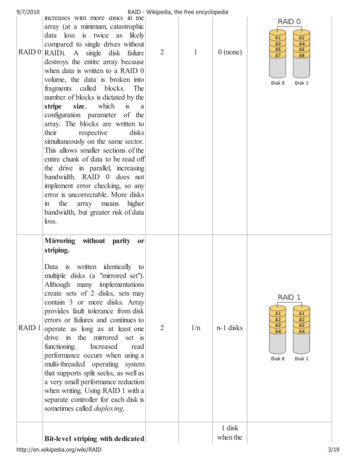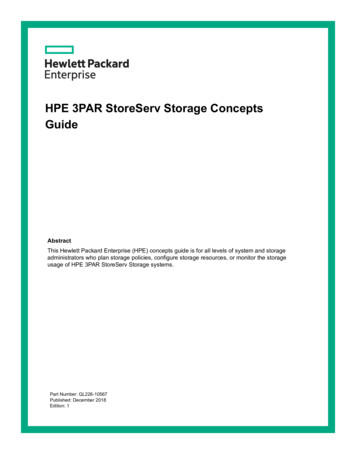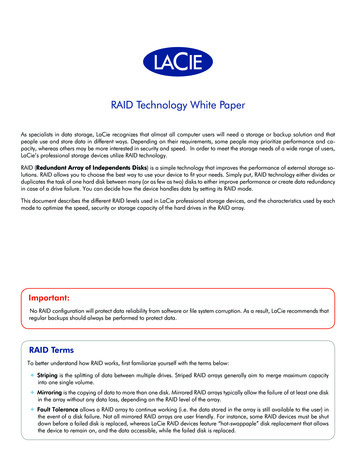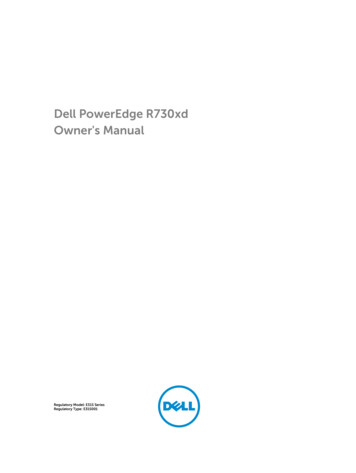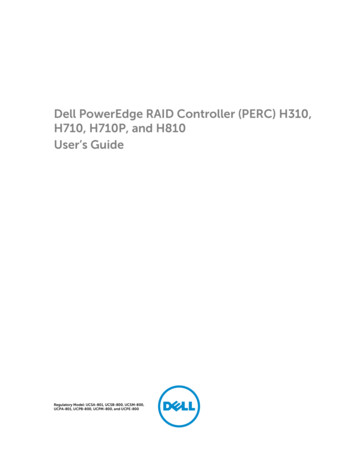
Transcription
Dell PowerEdge RAID Controller (PERC) H310,H710, H710P, and H810User’s GuideRegulatory Model: UCSA-801, UCSB-800, UCSM-800,UCPA-801, UCPB-800, UCPM-800, and UCPE-800
Notes, cautions, and warningsNOTE: A NOTE indicates important information that helps you make better use of your computer.CAUTION: A CAUTION indicates either potential damage to hardware or loss of data and tells youhow to avoid the problem.WARNING: A WARNING indicates a potential for property damage, personal injury, or death. 2016 Dell Inc. All rights reserved. This product is protected by U.S. and international copyright and intellectualproperty laws. Dell and the Dell logo are trademarks of Dell Inc. in the United States and/or other jurisdictions. All othermarks and names mentioned herein may be trademarks of their respective companies.2016 - 05Rev. A03
Contents1 Overview.9Supported Operating Systems. 10Getting help.11Contacting Dell. 11Related Documentation.11Documentation feedback.122 Features. 13Physical Disk Power Management.13Configured spin down delay. 13Types Of Virtual Disk Initialization. 14Background Initialization Of Virtual Disks. 14Full Initialization Of Virtual Disks.14Fast Initialization Of Virtual Disks. 14Consistency Checks. 15Disk roaming. 15Using disk roaming. 15FastPath.15Configuring FastPath-Capable Virtual Disks. 16Virtual Disk Migration. 16Migrating Virtual Disks. 17Virtual Disk Write Cache Policies. 17Write-Back And Write-Through.18Conditions under which write-back is employed.18Conditions under which forced write-back with no battery is employed.18Virtual Disk Read Cache Policies. 18Reconfiguration Of Virtual Disks.18Fault Tolerance. 21The SMART feature. 21Automatic Replace Member With Predicted Failure. 21Patrol Read. 22Redundant Path Support (For PERC H810 Only). 22Physical disk failure detection. 23Using Persistent Hot Spare Slots. 23Physical Disk Hot Swapping.23Using replace member and revertible hot spares.23Controller Cache Preservation. 24Cache Preservation With NVC. 243
Recovering Cache Data. 24Battery Transparent Learn Cycle. 24TLC time frame.24Conditions for replacing the battery. 253 Deploying The PERC Card. 26Removing The PERC Controller. 26Installing The PERC Controller. 29Support For Internal Multiple Controllers. 30Setting Up Redundant Path Support On The PERC H810 Adapter.30Reverting To Single Path Support From Redundant Path Support For PERC H810. 304 Driver Installation. 32Pre-Installation Requirements For Windows Driver Installation. 32Creating The Device Driver Media For Windows Driver Installation. 32Downloading Drivers From The Dell Systems Service And Diagnostic Tools Media ForWindows. 33Downloading Drivers From The Dell Support Website For Windows. 33Installing Driver During a Windows Server 2008/2008 R2 Installation.33Installing Windows Server 2008/2008 R2 For A New RAID Controller. 34Updating Existing Windows Server 2008 Or Windows Server 2008 R2. 34Updating The Linux Driver. 35Installing Or Updating The RPM Driver Package With DKMS Support. 35Installing Or Updating The RPM Driver Package With KMOD Support. 35Installing Or Updating The RPM Driver Package With KMP Support. 365 Management Applications For PERC Cards. 37Dell OpenManage Storage Management.37BIOS Configuration Utility.37Entering The BIOS Configuration Utility.38Exiting The Configuration Utility.38Menu Navigation Controls.38Setting Up Virtual Disks.40Virtual Disk Management. 41Creating Virtual Disks.41Selecting Virtual Disk Parameters. 42Converting Physical Disk To RAID Capable For PERC H310. 43Converting Physical Disk To Non-RAID For PERC H310.43Initializing Virtual Disks. 44Checking Data Consistency. 44Running A Data Consistency Check.44Importing Or Clearing Foreign Configurations Using The VD Mgmt Menu. 454
Importing Or Clearing Foreign Configurations Using The Foreign Configuration ViewScreen. 45Break Mirror. 47Managing Preserved Cache. 48Managing Dedicated Hot Spares.48Deleting Virtual Disks. 49Deleting Disk Groups. 49Clearing The Configuration. 50BIOS Configuration Utility menu options. 50Virtual Disk Management (VD Mgmt). 50Virtual Disk Actions.52Physical disk management (PD Mgmt).53Physical Disk Actions.53Rebuild. 54Controller management (Ctrl Mgmt).55Controller Management Actions. 55Foreign Configuration View.56Physical Disk Management. 56Setting LED Blinking. 56Creating Global Hot Spares. 56Removing Global Or Dedicated Hot Spares.57Replacing An Online Physical Disk.57Restrictions and limitations. 57Stopping Background Initialization.58Performing A Manual Rebuild Of An Individual Physical Disk. 58Controller Management. 58Enabling boot support. 58Enabling Boot Support For A BIOS-Enabled Controller. 59Enabling BIOS Stop On Error. 59Enabling Auto Import. 59Disabling Auto Import.60Restoring Factory Default Settings.60UEFI RAID Configuration Utility.60Entering The UEFI RAID Configuration Utility.60Exiting The UEFI RAID Configuration Utility. 61Configuration Options.61Controller Management Menu.61Virtual Disk Management. 62Physical Disk Management Menu.62Enclosure Management. 626 CacheCade.635
CacheCade Virtual Disk Characteristics.63Configuring And Managing CacheCade Virtual Disks. 63CacheCade Virtual Disk Management. 64Creating CacheCade Virtual Disks.64Deleting CacheCade Virtual Disks. 65Reconfiguring CacheCade Virtual Disks.65Automatic Reconfiguration Of CacheCade Virtual Disks. 65Manual Resizing Of CacheCade Virtual Disks.667 Security Key And RAID Management. 67Security Key Implementation.67Security Key Management In The BIOS Configuration Utility. 67Local Key Management (LKM). 68Creating A Security Key.68Changing the security key. 68Deleting a security key.69Creating Secured Virtual Disks. 69Securing pre-existing virtual disks.69Securing pre-existing virtual disks. 70Importing Or Clearing Secured Foreign Configurations And Secure Disk Migration.70Instant Secure Erase.71Troubleshooting Security Key Errors. 72Secured Foreign Import Errors.72Failure to Select Or Configure Non Self-Encrypting Disks (Non-SED). 72Failure to delete security key. 72Failure To Instant Secure Erase Task On Physical Disks. 728 Troubleshooting. 73BIOS Error Messages. 73Discovery error message.73Extra enclosure error message. 73Cache Data Lost Error Message.73Missing Disks In Virtual Disk Error Message. 74Previous configuration of disks removed error message. 74Missing virtual disks error message. 74Dirty Cache Data Error Message. 75BIOS disabled error message. 75Drive Configuration Changes Error Message. 75Adapter at baseport not responding error message.76Offline Or Missing Virtual Drives With Preserved Cache Error Message.76Virtual disks offline error message.76Virtual disks degraded error message.766
Virtual disks partially degraded error message. 77Memory or battery problem error message. 77Firmware fault state error message. 77Foreign configuration found error message. 77Foreign Configuration Not Found In Ctrl R Error Message. 78Previous configuration cleared or missing error message. 78Invalid SAS topology detected error message. 78Multibit ECC Errors Detected Error Messages. 78Configured Disks Removed Or Not Accessible Error Message. 79Battery Discharged Or Disconnected Error Message. 79Degraded State Of Virtual Disks. 80Memory errors. 80Preserved Cache State.80General issues. 80PERC Card Has Yellow Bang In Device Manager. 80PERC Card Not Seen In Device Manager. 81No Hard Drives Found Error Message During Microsoft Windows Server 2003 Installation. 81Physical disk issues. 81Physical disk in failed state. 81Unable to rebuild a fault tolerant virtual disk.81Fatal error or data corruption reported.82Physical disk displayed as blocked. 82Multiple Disks Become Inaccessible. 82Rebuilding A Failed Physical Disk.82Virtual disk fails during rebuild using a global hot spare. 83Virtual Disk Fails During Rebuild Using A Dedicated Hot Spare. 83Physical Disk Fails During Reconstruction On Redundant Virtual Disk. 83Virtual disk fails rebuild using a dedicated hot spare.83Physical disk takes a long time to rebuild. 83SMART errors.83Smart error detected on a physical disk in a redundant virtual disk. 84Smart error detected on a physical disk in a non-redundant virtual disk.84Replace member errors. 84Source disk fails during replace member operation.84Target disk fails.84General disk fails.85Linux operating system errors. 85Linux Will Not Boot Using an H310 Controller With IOMMU Enabled.85Virtual Disk Policy Is Assumed As Write-Through Error Message. 85Driver Does Not Auto-Build Into New Kernel. 85Unable to register SCSI device error message.86Disk Carrier LED Indicators.867
9 Appendix: RAID description. 88Summary Of RAID Levels.88RAID terminology.88Disk Striping.88Disk mirroring.89Spanned RAID levels. 89Parity data.908
1OverviewThe Dell PowerEdge RAID Controller (PERC) H310, H710, H710P, and H810 family of storage controllercards has the following characteristics: Complies with serial-attached SCSI (SAS) 2.0 providing up to 6 Gb/sec throughput. Supports Dell-qualified serial-attached SCSI (SAS) hard drives, SATA hard drives, and solid-state drives(SSDs).NOTE: Mixing SAS and SATA drives within a virtual disk is not supported. Also, mixing hard drivesand SSDs within a virtual disk is not supported.NOTE: Mixing disks of different speeds (7,200 rpm, 10,000 rpm, or 15,000 rpm) and bandwidth(3 Gbps or 6 Gbps) PCIe while maintaining the same drive type (SAS or SATA) and technology(HDD or SSD) is supported. Offers RAID control capabilities which include support for RAID levels 0, 1, 5, 6, 10, 50, and 60.NOTE: PERC H310 supports RAID 5 with limited performance and does not support RAID 6 andRAID 60. Provides reliability, high performance, and fault-tolerant disk subsystem management. Offers Non-RAID support for direct access to disk drives (PERC H310 only).NOTE: Operating systems can directly access Non-RAID hard drives. A Non-RAID hard drive isnot fault-tolerant and cannot be recovered if it fails. Only the PERC H310 controller allowsconfiguration of disk drives as Non-RAID.The following table compares the hardware configurations for the PERC H310, H710, H710P, and H810cards.Table 1. PERC H310, H710, H710P, and H810 Cards Hardware ConfigurationsSpecificationH310H710H710PH810RAID Levels0, 1, 5, 10, 500, 1, 5, 6, 10, 50,600, 1, 5, 6, 10, 50, 600, 1, 5, 6, 10, 50, 60Enclosures PerPortNot ApplicableNot ApplicableNot ApplicableUp to four enclosuresProcessorDell Adapter SASRAID-on- Chip,8-port with LSI2008 chipsetDell Adapter SASRAID-on- Chip,8-port with LSI2208 chipsetDell Adapter SASRAID-on- Chip, 8port with LSI 2208chipsetDell Adapter SAS RAIDon- Chip, 8-port withLSI 2208 chipsetBackup BatteryUnit (BBU)NoYesYesYesNon-VolatileCacheNot ApplicableYesYesYes9
SpecificationH310H710H710PH810Cache MemoryNot Applicable512 MB DDR3800 Mhz1 GB DDR3 1333Mhz1 GB DDR3 1333 MhzCache FunctionNot ApplicableWrite Back, WriteThrough,Adaptive ReadAhead, No ReadAhead, ReadAheadWrite Back, WriteThrough, AdaptiveRead Ahead, NoRead Ahead, ReadAheadWrite Back, WriteThrough, AdaptiveRead Ahead, No ReadAhead, Read AheadMaximumnumber of spansper Disk Group8888Maximum16number of VirtualDisks per DiskGroup161616Online CapacityExpansionYesYesYesYesDedicated andYesGlobal Hot Spares
Complies with serial-attached SCSI (SAS) 2.0 providing up to 6 Gb/sec throughput. Supports Dell-qualified serial-attached SCSI (SAS) hard drives, SATA hard drives, and solid-state drives . Specification H310 H710 H710P H810 Cache Memory Not Applicable 512 MB DDR3 800 Mhz 1 GB DDR3 1333 Mhz 1 GB DDR3 1333 Mhz
